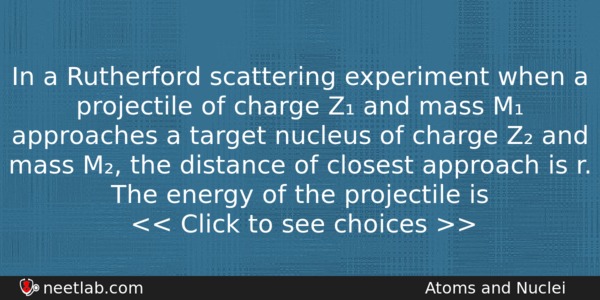| ⇦ | 
| ⇨ |
In a Rutherford scattering experiment when a projectile of charge Z₁ and mass M₁ approaches a target nucleus of charge Z₂ and mass M₂, the distance of closest approach is r. The energy of the projectile is
Options
(a) directly proportional to Z₁ Z₂
(b) inversely proportional to Z₁
(c) directly proportional to mass M₁
(d) directly proportional to M₁ x M₂
Correct Answer:
directly proportional to Z₁ Z₂
Explanation:
The kinetic energy of the projectile is given by
1/2 mv² = Ze (2e) / 4π?¬ツタr₀
= Z₁ Z₂ / 4π?¬ツタr₀
Thus energy of the projectile is directly proportional to Z₁, Z₂.
Related Questions: - During negative β-decay
- Two similar springs P and Q have spring constants Kp and Kq, such that Kp>Kq.
- A ball is moving in a circular path of radius 5 m.If tangential acceleration
- Two masses of 9 g and 6 g are connected with a string which is passing over a frictionless
- There are four light-weight-rod samples A,B,C,D seperately suspended by threads
Topics: Atoms and Nuclei
(136)
Subject: Physics
(2479)
Important MCQs Based on Medical Entrance Examinations To Improve Your NEET Score
- During negative β-decay
- Two similar springs P and Q have spring constants Kp and Kq, such that Kp>Kq.
- A ball is moving in a circular path of radius 5 m.If tangential acceleration
- Two masses of 9 g and 6 g are connected with a string which is passing over a frictionless
- There are four light-weight-rod samples A,B,C,D seperately suspended by threads
Topics: Atoms and Nuclei (136)
Subject: Physics (2479)
Important MCQs Based on Medical Entrance Examinations To Improve Your NEET Score
18000+ students are using NEETLab to improve their score. What about you?
Solve Previous Year MCQs, Mock Tests, Topicwise Practice Tests, Identify Weak Topics, Formula Flash cards and much more is available in NEETLab Android App to improve your NEET score.
Share this page with your friends

Leave a Reply